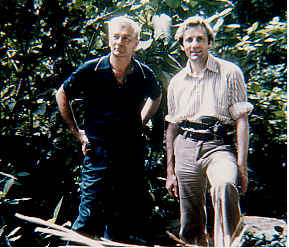The Tunnels of Juan Moricz
 It was in 1976 that Stan Hall, guided by the Ecuadorian explorer Juan Moricz, organized an expedition to survey the entire cave system of “Cueva de los Tayos”. This expedition was a joint British/Ecuadorian venture, and included a team of geologists and botanists as well as one hundred soldiers of the Ecuadorian army, whose task it was to provide security.
It was in 1976 that Stan Hall, guided by the Ecuadorian explorer Juan Moricz, organized an expedition to survey the entire cave system of “Cueva de los Tayos”. This expedition was a joint British/Ecuadorian venture, and included a team of geologists and botanists as well as one hundred soldiers of the Ecuadorian army, whose task it was to provide security.
Searching for a distinguished patron who could provide credibility to the whole enterprise, Hall approached a man who had strong Scottish connections. To his surprise and delight, this man agreed to accompany them on the expedition.
The name of this man was Neil Armstrong, the first man to walk upon the moon. By an unusual twist of fate, the story which had begun with an author famed for his theory of “ancient astronauts”, now involved the most famous astronaut of them all.
During the three weeks that his team remained on site to investigate these subterranean caverns, Stan Hall was unable to find any trace of the Metal Library. His team did however find a seated body in a burial chamber inside the cave that was dated to 1,500 B.C.
Juan Moricz originally collaborated with Hall and agreed to help him search for the Metal Library that supposedly lay hidden within these caverns. But when it became apparent that it was Hall who would gain the glory if this library was discovered, Moricz abruptly terminated all dealings with him.
Juan Moricz never again discussed in public his association with the Metal Library, and he refused to divulge the exact location of the entrance to the subterranean tunnels. He died in February 1991, taking his secret with him to the grave.
Sadly, the possibility of anyone else finding this Metal Library via the “Cueva de los Tayos” has also ended. When the Ecuadorian authorities realized that ancient golden artifacts might be found within this cave system, a Government seal was placed at the entrance. It has been permanently guarded ever since.
Although the Hall expedition failed in its attempt to discover the Metal Library, it did establish beyond doubt that an extensive system of underground tunnels did exist, and that these tunnels were artificially constructed. In fact they looked exactly like the description that von Däniken had given in his book “The Gold of the Gods”.
“The passages all form perfect right angles. Sometimes they are narrow, sometimes wide. The walls are smooth and often seem to be polished. The ceilings are flat and at times look as if they were covered with a kind of glaze.”
 The rumors of artificial tunnels that existed deep beneath the ground did not begin with Juan Moricz. Soon after Francisco Pizarro and his band of conquistadores arrived in Peru in 1532, stories began to circulate about hoards of golden treasure that had been hidden by the Incas in a vast network of underground tunnels. It did not take long for these rapacious hunters of gold to search for these underground hiding places.
The rumors of artificial tunnels that existed deep beneath the ground did not begin with Juan Moricz. Soon after Francisco Pizarro and his band of conquistadores arrived in Peru in 1532, stories began to circulate about hoards of golden treasure that had been hidden by the Incas in a vast network of underground tunnels. It did not take long for these rapacious hunters of gold to search for these underground hiding places.
While exploring Huascaran, the highest mountain in Peru and a place that was revered by the Incas, a Spanish force discovered a cave whose interior was blocked off by large slabs of rock. Although they suspected that these stone blocks might conceal a hidden storage room beyond, they were unable to gain access to it. However the story was recorded by one of the chroniclers who accompanied the group.
It was not until 1971 that a well-equipped expedition was organized to investigate the site. This expedition consisted of speleologists equipped with all the necessary technical support. At the far end of the cave, they found six water-tight doors made of enormous blocks of stone. But despite their tremendous weight, these doors were pivoted in such a way that four men were able to push them open.
Beyond these doors lay a system of tunnels that had been carved out of the rock. According to a report in the German periodical “Bild der Wissenschaften” which covered this expedition, the floors of these tunnels were pitted and grooved to make them slip-proof. They descended downwards at an angle and led straight towards the coast, a distance of some sixty miles away.
Where these tunnels finally ended proved impossible to tell, for they appeared to continue on under the sea heading in the direction of the island of Guanape, located a short distance off the coast. What astonished the members of the expedition was that the air in these tunnels was breathable, indicating that a source of fresh air somehow existed in the tunnels.




